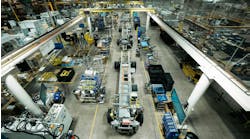Earlier this year, the Environmental Protection Agency finalized its SmartWay Technology Program to include trailer aerodynamic equipment verification. Designed to allow fleets to better identify trailer equipment with demonstrated fuel saving capability, and to offer manufacturers more testing flexibility, EPA replaced device-based categories with performance thresholds of 1%, 4%, 5% and 9% or more fuel savings over traditional trailers.
EPA also announced a new classification for 53-ft. dry van or refrigerated trailers in long-haul operations that are equipped with a higher-level of verified aerodynamic devices. A newly designated SmartWay Elite trailer can save a total of 10% or more in fuel over traditional trailers, with at least 9% of the fuel savings resulting from reducing wind drag with a combination of two or more EPA-verified aerodynamic devices, including side skirts, tails and gap reducers.
“The new EPA technology verification testing options take out a lot of the variables,” says Tom Gerst, design engineer at Fleet Engineers, the maker of Aeroflaps and Aerosaver side skirts. “Wind tunnel, coast down and computational fluid dynamic testing provide an exact comparison and allow more new products to come onto the market that will meet SmartWay’s Elite aerodynamic technology grouping for 9% or higher fuel savings.”
“It’s generally accepted that trailer side skirts are effective for fuel savings,” notes Bob Montgomery, vice president of Stemco ITMS group, which recently acquired ATDynamics Inc. and now offers the ATDynamics TrailerTail and EcoSkirt. “We’re seeing fleets question rear drag technologies, and we speculate that it shouldn’t be long before the data on those devices is so overwhelming that fleets can’t delay deploying them any longer.”
Trailer manufacturer Wabash National recently introduced the AeroFin tail device, which deploys and retracts automatically with swing door operation; the Ventix DRS drag reduction system of segmented panels, which is used to manage airflow along the length of the trailer; and the DuraPlate AeroSkirt CX, a trailer side skirt that weighs about 25% less than its predecessor.
Jim Reiman, CEO at Aerofficient, the provider of a wide range of trailer side skirts, focuses on refrigerated trailers. “The aerodynamics of a reefer are different because the fuel tank blocks airflow beneath the trailer,” he says. “Our solution shields and directs airflow away from the refrigeration unit’s fuel tank.” He says the company is also seeing growing interest in side skirts for intermodal chassis, which he states can deliver savings similar to those for van trailers.
Utility Trailer offers side skirts made of FRP (fiberglass reinforced plastic). Among the range of trailer aerodynamic products on the market as well is the new Fleetline Aero-Line, which now includes trailer skirts, vortex generators and wheel covers.
The AeroFlex Maxx is Freight Wing’s new full coverage side skirt. According to the manufacturer, the latest design uses an aerodynamic geometry similar to the original Freight Wing AeroFlex to produce more fuel savings. Freight Wing also offers a gap fairing and the Freight Wing Chassis Fairing, which can be clamped onto the I-beams of nearly any container chassis.
The Ridge Green Wing aerodynamic trailer side skirt, according to the company, was refined in a wind tunnel to create a design that redirects turbulent air behind the tractor drive axles.
Laydon Composites offers several aerodynamic trailer fairings, including the flat panel Trailerskirt, a new Trailerskirt-Wishbone model, and the Trailerskirt Classic with multi-fluted panel sections. It also provides nose fairings and a vortex stabilizer to help streamline airflow in the tractor-trailer gap.
Trailer aerodynamic devices from Transtex Composite include skirts, Edge Cone gap reducer, and Edge Tail rear fairing.
Other side skirt products on the market include the Strehl TrailerBlade, the Airflow Deflector, the Avantechs VorBlade vortex generators, the SmartTruck Trailer UnderTray and TopKit Systems, and the Airman AirWedge II under the trailer device.
All manufacturers report that fleets are increasingly adopting trailer aerodynamic technologies, adding individual components and systems in configurations that help save fuel in each particular application.
For more information, visit these websites:
Aerofficient
www.aerofficient.com
AirFlow
www.airflowdeflector.com
Airman
www.airmansystems.com
ATDynamics
www.atdynamics.com
Avantechs
www.vorblade.com
Fleet Engineers
www.fleetengineers.com
Fleetline
www.fleetlineproducts.com
Freight Wing
www.freightwing.com
Laydon Composites
www.laydoncomp.com
Ridge Corp.
www.ridgecorp.com
SmartTruck
www.SmartTruckSystems.com
Strehl
www.strehlusa.com
Transtex
www.transtexcomposite.com
Utility Trailer
www.utilitytrailer.com
Wabash Composites
www.wabashcomposites.com


